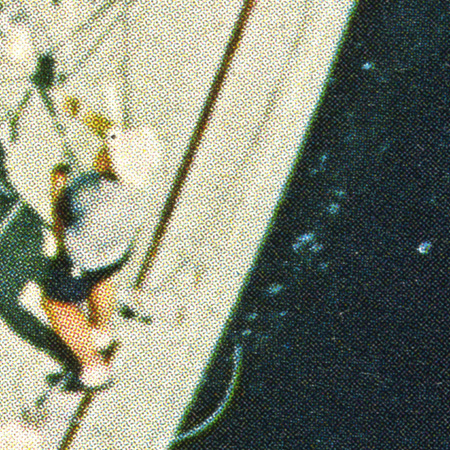Photoshop Question / Problem

Edit: James solved it, thanks a lot!
I am trying to accomplish something in Photoshop and am having a hard time getting it to work. I was hoping maybe someone could shed some light. Here’s some background on the problem:
I have 30 instances of a single smart object in a composition. They are scaled to various sizes and are placed in various positions. The smart object contains a raster image that is about 1500x1500px wide. I used that size to keep things small when creating the composition but now I want to scale everything up to poster size. The image inside of the smart object is not big enough for poster size so I need to replace its contents with a higher resolution version (around 3000x3000px). The problem is that when I replace the contents of the smart object with the higher resolution image, all of the placed instances of it in the original composition scale up accordingly.
So here’s my question: Is it possible to replace the contents of a smart object with a higher resolution version while maintaining the scale of it’s instances in the composition? Meaning if there is a smart object instance in the composition that measures 900px wide, it will stay 900px wide no matter what size image I replace it’s contents with.
Putting another smart object containing the higher resolution version inside of the original smart object did not work, it seems to rasterize the inner smart object at the smaller scale before placing the outer one in the composition. Doing a Layer > Smart Object > Replace Contents did not work either.
Any ideas would be greatly appreciated in the comments.

18 Comments Leave A Comment
Philipp Antoni says:
November 1, 2009 at 12:00 pmSimply increasing the DPI of the smart object does the trick.
Julius says:
November 1, 2009 at 12:03 pmI think this may be a stretch but what if you place the high res version into an illustrator file first, then paste that into the smart object you’re replacing?
Haven’t done this successfully or anything, just the first thing that came to mind.
James says:
November 1, 2009 at 12:06 pmI *think* I have it. I actually felt it wouldn’t be possible so tried it out, and was suprised that I actually got it to work – Here’s what I did…
1. I created a new canvas, drew a large vector shape, converted to smart object, duplicated that layer a few times and scaled to different (smaller) sizes… also, kept the original smart object instance at original scale.
2. I then scaled up the image by 400%. Now my smart-objects looked “ok” in the smaller sizes, but the original (large) version of the smart object had a blurred/pixelated edge (as you would expect)…
Here’s the key…
3. I opened the smart object file, and then raised the resolution by 400% …IMPORTANT: I took it from 72 to 288 (4×72)… so, the pixel X pixel size increased, the cm X cm remained the same.
4. Hit save, checked my main oringial image with all the smart objects…
All fine.
Hope that makes sense…
J.
Nate says:
November 1, 2009 at 12:06 pmI’ve run into similar problems as it relates to resolution and duplicated smart objects with, unfortunately, no found solution. I have an idea but am not at my machine and able to test. So this could be with no avail. Maybe worth a shot.
This is also based on an assumption that the resolution of the final poster resolution and the interior of the smart objects are mismatched. Here’s my suggestion. Keep the smart object at its resolution and instead make your overall poster resolution the same. Keep the overall poster pixel dimensions the same as it was when it was it was saved at the larger resolution, but match the dpi of the overall poster to that of the smart object’s interior. The physical dimensions of the poster will be off, but the poster can be changed back to the proper dpi (again keeping the pixel densions the same) after the poster is finished and flattened, and the physical dimensions will be back to normal.
I believe that once the two dpi’s are no longer mismatched, the scaling issue will be resolved. Hopefully this all makes sense or maybe it’s alreay been tested. Good luck!
James says:
November 1, 2009 at 12:07 pmWow. You have to be quick around here – I agree with what Philipp says :)
Philipp Antoni says:
November 1, 2009 at 12:15 pmScott:
When I change the DPI of a smart object (with “resample image”) it obviously does scale up the smart object but in the end, after saving, their size stays the same in the original document.
Basically that’s exactly what James described as well and it seems to work for both of us. Maybe a change in CS4?
Scott says:
November 1, 2009 at 12:20 pmJames & Nate-
I see what you’re saying, but I must be missing something. when I change the image resolution with “resample” checked, it just scales the image up pixel wise, and then I have the same problem I started with. if I change the resolution without “resample” checked then the print size decreases, when I try to place the higher res version it’s too big for the document, and I have to resize, which again, puts me right back where I started.
am I missing something?
James says:
November 1, 2009 at 12:21 pmIf I scale up the smartobject source file by it’s cm X cm dimensions, that DOES then break the original image (all smart objects scale up)… but if the physical print dimensions remains the same, it seems to work fine, for me…
@Philipp: Good point, I’m also using CS4 (PC)…
Scott says:
November 1, 2009 at 12:27 pmJames-
nice! it worked… thanks so much, great idea. so I guess photoshop uses the print size (not pixel size) to determine object scale. Shirt + Poster coming your way…
James says:
November 1, 2009 at 12:30 pmHey! No problem, glad it worked out!
Nate says:
November 1, 2009 at 12:39 pmIndeed. Good job! My pride is bruised as I was fumbly attempting to describe just that. But you nailed it. *cue string section. Haha
Scott says:
November 1, 2009 at 12:55 pmnate-
yeah, you basically explained the same thing, much appreciated… I’m emailing you too.
James says:
November 1, 2009 at 1:44 pmHaving problems with my email at the moment, updated my contact address on this post – Thanks
Philipp Antoni says:
November 1, 2009 at 2:28 pmYup, nicely explained, James.
WAcreative says:
November 1, 2009 at 10:57 pmHaven’t read the other suggestions but mine would be import these images (the full rez) into Illustrator. That way it still a smart object (or can be), it can still be edited by doubled clicking the smart object thumb in layers and you can have them all different sizes.
Joe says:
November 7, 2009 at 4:24 pmCS3 works the way you initially describe, where the placed smart object remains the same dimensions after modification. They changed the behavior in CS4 to alter the scale instead, without a way to choose how you would like it to be handled. Adobe probably made the change for usability, but broke the previous workflow in the process.
I’d like to see the smart object model be extended to support referenced/linked -and- embedded PSBs. Modified reference files would get an indicator that the source changed, but still keep an embedded copy. A new option to Reload/Refresh contents could join the ‘Replace contents’ function.
In addition, a way to cleanly ‘Release contents’ would be helpful.
Sha says:
November 13, 2009 at 7:59 amIn CS4 when I edit a smart object for instance I take a box that is 480 x 70 and make it 450×70 then save the smart object. When it updates it in photoshop and I hit the show transform controls then hit control – t, it still shows a bounding box of 480 x 70. Does anyone know a work around this?
Clayton says:
November 16, 2009 at 8:51 pmSha –
This may be a bit late… but I think the problem you’re having stems from not trimming the canvas of your smart object before you save it to go back to the original document.
For instance, if you do what you said; open a document, make a box 480×70, convert it into a smart object. Double-click that smart object to open it up for editing. Resize the box within the smart object to 450×70. Save. Go back to your original document.
Now… at this point, you’re correct, trying to resize the smart object will reveal that the transform controls are still stuck at the original smart object’s size (480×70),
But… if you “trim” (Image>Trim…) your canvas (removing all excess transparent canvas space surrounding the box), then save , then go back to your original document and try to transform your smart object, you’ll see that the transform controls sit nicely at your box’s new size (450×70).
Hope this helps…